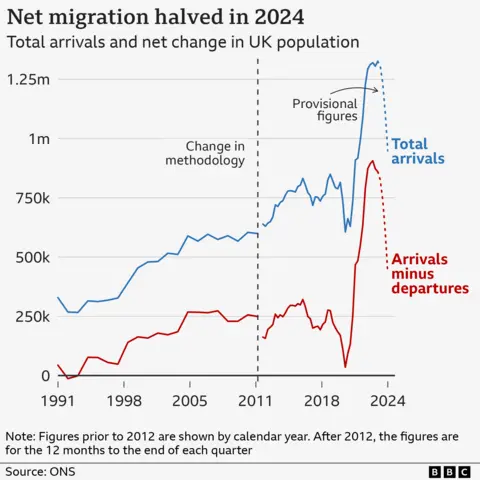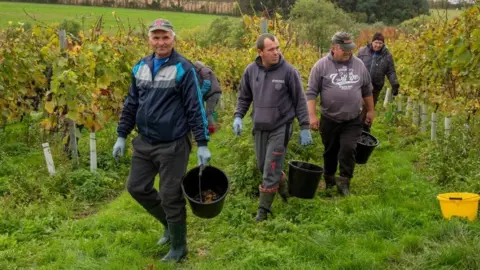Migration: How many people come to work and study in the UK?
 Getty Images
Getty ImagesNet migration to the UK fell almost 50% to 431,000 in 2024.
The government has set out measures it says will further reduce numbers.
How many migrants come to the UK?
An estimated 948,000 people came to the UK expecting to stay at least a year in 2024, according to provisional figures from the Office for National Statistics (ONS).
It estimates that 517,000 people left the country.
The net migration figure of 431,000 is the number of people coming to the UK, minus the number leaving.
Net migration in the 12 months to December 2023 was estimated at 860,000.

Of those who came to live in the UK in the 12 months to December 2024:
- 60,000 (6%) were British nationals
- 122,000 (13%) were EU nationals, or from Norway, Iceland, Liechtenstein and Switzerland (EU+)
- About 766,000 (81%) were from other countries
Among non-EU+ migrants, 83% were aged 16 to 64 and the most common nationality coming for work or study was Indian.
Over the period, 96,000 more EU nationals left the UK than arrived.
About 17,000 more British nationals left the UK than came back.
How does the government plan to reduce immigration?
In May, the government unveiled plans to cut immigration further, including:
- English tests for all visa applicants and adult dependants
- Skilled worker visas to generally require a degree-level qualification, instead of an A-level equivalent, and higher salary thresholds
- Overseas graduates to be allowed to remain for 18 months after their course, instead of two years
- Immigrants will typically have to live in the UK for 10 years before applying for the right to stay indefinitely – up from five years
- Employers to be encouraged to find and develop domestic talent
- It will be made easier to remove or refuse entry or asylum to people who breach immigration rules or break the law
How have the salary rules for UK visa applicants changed?
Most people wanting to work in the UK have to apply for a visa through the points-based system (PBS).
Since April 2024, applicants have to earn at least £38,700 - an increase of nearly 50% from the previous £26,200 minimum.
The threshold does not apply to some jobs - such as in health and social care.
How does the points-based system work?
Applicants need 70 points to qualify for a skilled worker visa, which can last up to five years before it needs to be extended.
Having a job offer above a minimum skill level and speaking English is worth 50 points.
The remaining 20 points can come from a job offer with a higher salary, working in a sector with job shortages, or having a relevant PhD.
The standard fee for a skilled visa is usually between £719 and £1,639. Applicants also have to pay a healthcare surcharge.
What is the immigration salary list?
The immigration salary list replaced what was previously called the shortage occupation list.
It helps employers fill vacancies in key sectors.
These jobs have a lower salary threshold.
 Getty Images
Getty ImagesThe list includes:
- health and care workers
- pharmacists
- graphic designers
- some farming and fishing roles
- construction workers
How many people get visas to work in health and social care?
Home Office figures show that 23,000 visas were issued to people coming to the UK to work in health and social care in the 12 months to March 2025.
That is 85% fewer than were issued at the peak in 2023.
Numbers increased significantly after temporary changes to the health and care visa rules in February 2022. These ended in June 2025.
What are the rules about family visas and how many are given?
A family visa is needed if someone wants to live with a relative who is a British citizen, or someone who has the right to be in the UK for more than six months
People can apply to live with a:
- spouse or partner
- fiancé, fiancée or proposed civil partner
- child
- parent
- relative who will provide long-term care for you
The relative must meet a minimum income threshold.
The previous Conservative government had planned to increase this to £38,700 - up from £18,600.
But after warnings that this risked separating families, the new minimum was set at £29,000.
Anyone renewing an existing family visa does not have to meet the new earnings threshold.
The latest Home Office figures show that 76,000 family-related visas were granted in the year ending March 2025.
That's a 3% fall from the number issued in the 12 months to March 2024, but more than double the number granted in the year to March 2021.
How many student and graduate visas are issued?
 Getty Images
Getty ImagesAccording to Home Office figures for the year to March 2025, 403,000 student visas were issued to foreign students.
That is 10% fewer than in the 12 months to March 2024, but 50% more than the same period in 2019.
In the year ending March 2025, 18,000 visas were issued to student dependants, an 83% drop compared with the 12 months to March 2024.
Since January 2024, international postgraduate students have not been able to bring dependants unless their course is a research programme.
What are the rules for seasonal worker visas and how many are issued?
Temporary workers such as fruit pickers and poultry workers are covered by seasonal worker visas, which are subject to an annual quota.
The number of visas that can be granted is 45,000 for 2025:
- 43,000 horticulture workers
- 2,000 poultry workers
 Getty Images
Getty ImagesHome Office figures show 34,700 seasonal worker visas were issued in the year to March 2025.
More than three-quarters were for workers from Central Asian countries, such as Kyrgyzstan, Tajikistan, Uzbekistan and Kazakhstan.
